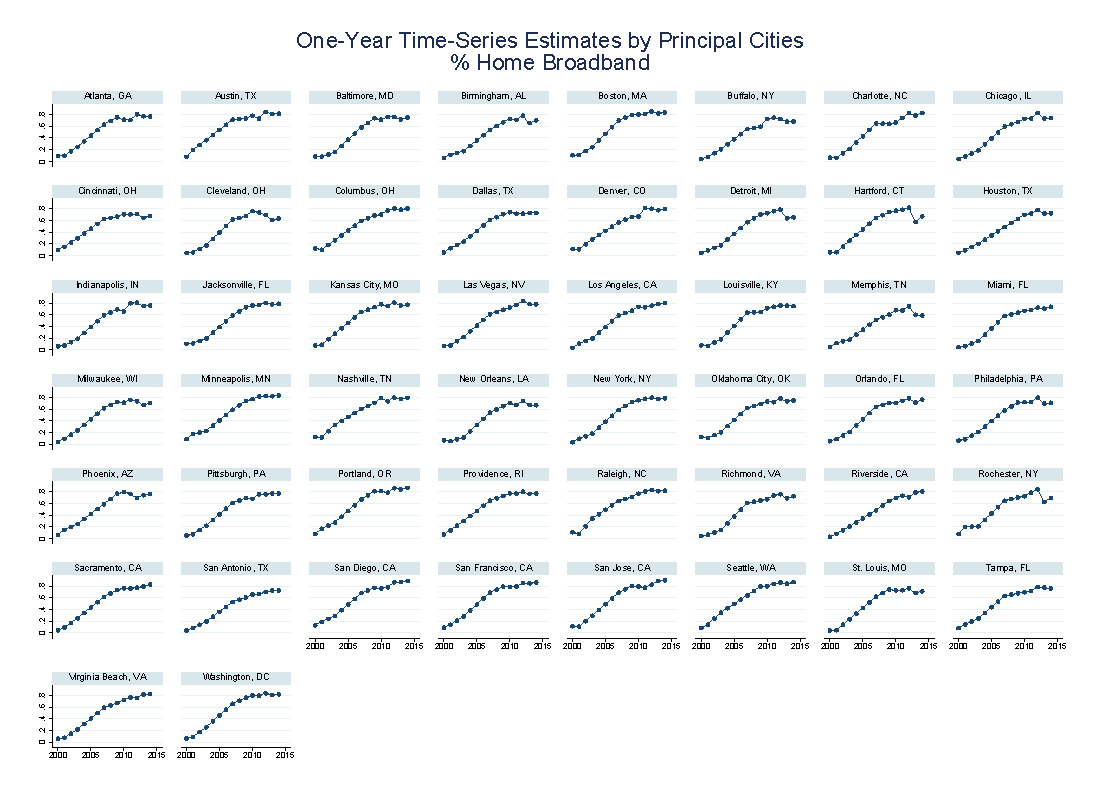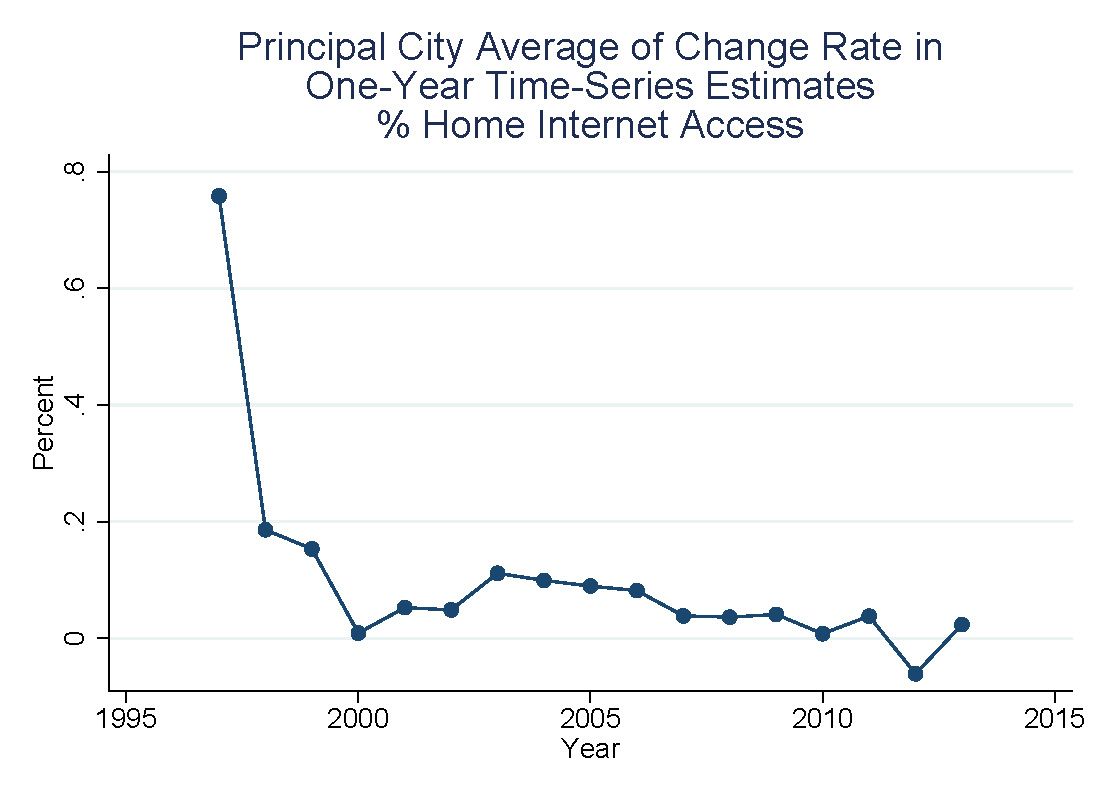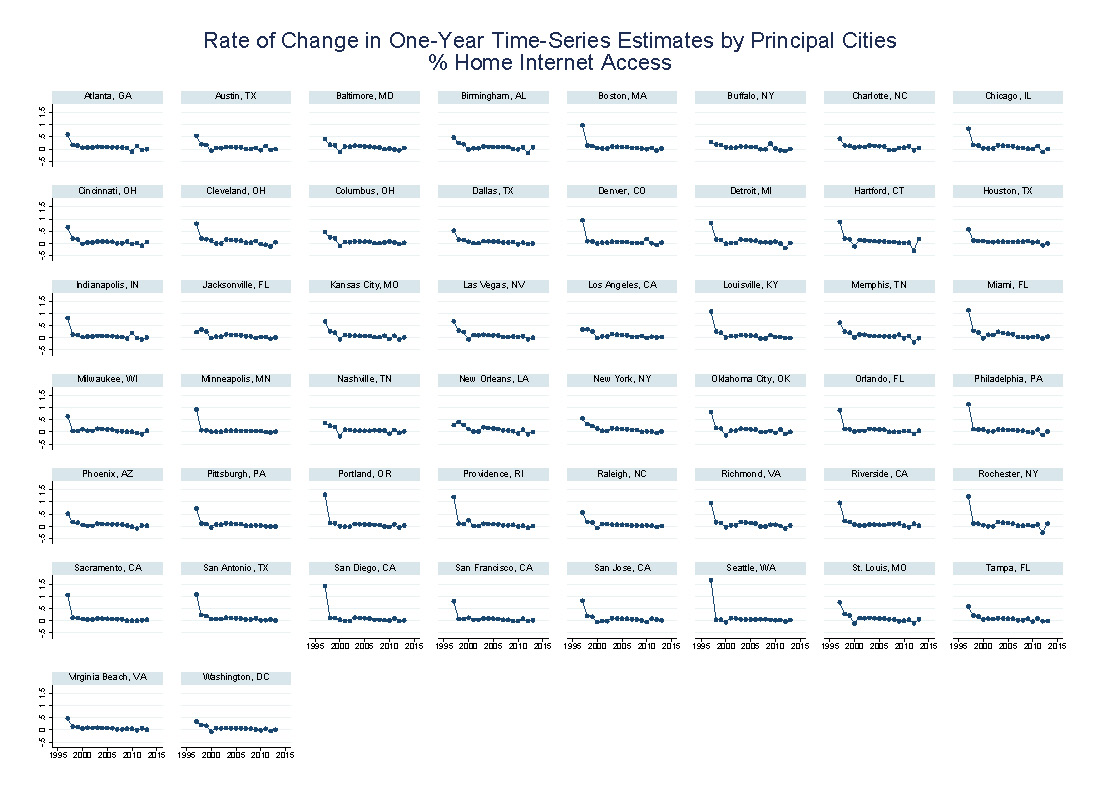City Data
Please cite use of this data as:
Tolbert, Caroline, and Mossberger, Karen, 2015, “U.S. Current Population Survey & American Community Survey Geographic Estimates of Internet Use, 1997-2014.”
The estimates presented here are for the principal cities in the 50 largest Metropolitan Statistical Areas (MSAs), and can be compared to the corresponding metro data as well as over time and across cities. These 1997-2014 estimates on Internet use in principal cities are unique, as city-level estimates were not available from the U.S. Bureau of the Census until 2014. Additionally, we provide estimates for demographic groups within cities for 2013 and 2014.
Principal cities within metropolitan regions may demonstrate different patterns of Internet use than their metropolitan areas. With the growth of some suburban communities, the U.S. Census now characterizes as the “principal cities” of a Metropolitan Statistical Area both the largest, or central city, and large suburbs. Often central cities (or larger and older suburbs) contain higher percentages of low-income residents who are also digitally disadvantaged. [1]
City Internet use is estimated from the Current Population Survey (1997-2012) and American Community Survey (ACS, 2013 and 2014). A group of random intercept logistic regressions (a type of multilevel model) are constructed for each of the Internet-related variables, namely, home Internet access, home broadband, mobile Internet, and fully-connected household (with broadband and mobile). Estimates are based on the U.S. Bureau of the Census Current Population Survey data for 1997, 1998, 2000, 2001, 2003, 2007, 2009, 2010, 2011, and 2012 and the U.S. Bureau of the Census American Community Survey 2013 and 2014, with estimates for missing years imputed via linear interpolation.
Using Summary Tables of the 2013 and 2014 American Community Survey available in FactFinder, City estimates were created for home Internet access and home broadband by race, ethnicity, education, age, and employment status.
Using microdata from the 2013 American Community Survey, City estimates were developed for home Internet access, home broadband, mobile Internet, and fully connected households broken down by race, ethnicity, education, age, family income, and language skill.
See Codebook here for a more complete description of the datasets, sources of data, survey questions, and methods. CodebookMethodsNSF_BB.pdf
Example summary figures of this Principal City data is available here PrincipalCitiesFigures.pdf



DATA
This City Time Series data set contains the yearly estimates of the percentage of Internet use in U.S. cities along with their populations in 2014. The percentage of home Internet access goes back to 1997 from 2014, home broadband to 2000 from 2014, and mobile Internet and fully connected household to 2011 from 2014.
The CPS data is disaggregated with household weights to create the Internet estimates for 1997, 1998, 2000, 2001, 2003, 2007, 2009, 2010, 2011, and 2012. The ACS summary tables of cities from American FactFinder provide the Internet estimates for 2013 and 2014 and the estimates for the missing years are imputed via linear interpolation.
This City Three Year Average data set takes the three-year moving average of the Internet estimates. The data set contains the yearly estimates of the percentage of Internet use in the principal cities in the 50 largest metropolitan areas in the U.S. The percentage of home Internet access is estimated between 1998 and 2013, and home broadband between 2001 and 2013. Because of the very short time series, three-year moving averages are not estimated for mobile Internet and fully-connected household.
This City Time Services Change Rate data set is based on CityTimeSeries.xls, and it estimates the yearly rate of change in the percentage of home Internet access, home broadband, mobile Internet, and fully-connected households in U.S. principal cities.
CityThreeYearAverageChangeRate.xls
This City Three Year Average Change Rate data set is based on cityThreeYearAverage.xls, and it estimates the yearly rate of change in the percentage of home Internet access and home broadband in U.S. principal cities.
CityYearlySummaryStatistics.xls
This City Yearly Summary Statistics data contains the summary statistics of the percentage of Internet use in city across years. It summarizes home Internet access, home broadband, mobile Internet, fully connected household for single-year city estimates (cityTimeSeries.xls), and home Internet access and home broadband for three-year moving averages (cityThreeYearAverage.xls).
This City 2013 ACS Fact Finder data set contains the 2013 estimates of the percentage of Internet use in U.S. city areas along with their 2013 populations. It is based on summary tables of the 2013 American Community Survey from American FactFinder. For home Internet access and home broadband, the estimates are broken down by race, ethnicity, education, age, and employment status.
This City 2013 ACS Microdata data set contains the 2013 estimates of the percentage of Internet use in U.S. cities. The estimates are generated by disaggregating the 2013 American Community Survey 1-Year Public Use Microdata Sample which was obtained through Minnesota Population Center. For home Internet access, home broadband, mobile Internet, and fully connected household, the estimates are broken down by race, ethnicity, education, age, family income, and language skill.
This City 2014 ACS Fact Finder data set contains the 2014 estimates of the percentage of Internet use in U.S. cities along with their 2014 populations. It is based on summary tables of the 2014 American Community Survey from American FactFinder. For home Internet access and home broadband, the estimates are broken down by race, ethnicity, education, age, and employment status.